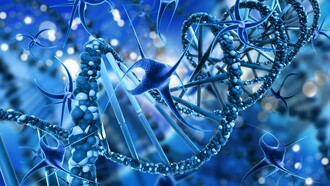A person lays down before a gun, which is pointed at its head. But this is a very special gun, it's rigged to a machine that measures the spin of a Quantum particle. Each time the trigger is pulled, the spin of the Quantum particle is measured. Depending on the measurement, the gun will either fire, or it won't.
Nervously, the individual takes a breath and pulls the trigger. The gun just clicks. It pulls the trigger again. Another click. And again: click. The person will continue to pull the trigger again and again with the same result: the gun does not fire. Although it's functioning properly and loaded with bullets, no matter how many times the trigger is pulled, the gun will never fire. The person will continue this process for eternity, becoming “immortal”...
Quantum mechanics is a topic that almost no one understands; for the vast majority, it is not very intuitive or even logical. The main difference between the classical mechanics we experience every day and Quantum mechanics comes down to predictability and limitation. We can see classical mechanics in our everyday lives: the gears of our great machines spin around and around while trains and airplanes move following Newton's laws. These things are real, with a clear past and a future that we can understand. But these same Newtonian laws break down once we enter a microscopic scale. There’s a strangeness infused here. The nature of the Quantum world is not definite but probabilistic. Setting up identical experiments won’t give you identical results. The regularity of Quantum mechanics doesn’t come from individual measurements, it comes from the statistical distributions of many measurements. You cannot, for example, know where anyone particle will end up even if you have the exact same experiment with the exact same particle. But statistical regularities allow you to establish where the particle is most likely going to end up. The probability of finding it in one location will be higher than finding it in another. Electrons, quarks, neutrinos, and other particles all follow this behavior.
During the famous double-slit experiment, electrons fired at a barrier containing two slits will create an interference pattern, behaving as if they know there are two slits even when individual particles are fired one at a time. It’s only until a detector or observer of some kind is introduced to the experiment that the electrons choose a single slit, creating the two bands scientists originally expected from regular matter. When they are not being observed, particles will behave like waves as they travel from their source to their destination. This behavior, along with the probabilistic nature of Quantum mechanics, gives us particles’ probability waves.
Let’s go back again to our deadly Quantum gun. The person pulls the trigger for the very first time but this time the gun fires. The person is dead.
But, wait. The “mortal” already pulled the trigger the first time, and an infinite amount of times following that, and we already know the gun didn't fire. How can the person be dead? The thing is that it is unaware, but the person is both alive and dead. Each time the trigger is pulled, the universe is split in two. It will continue to split, again and again.
This hypothetical experiment is called Quantum suicide. It was first posed by then-Princeton University theorist Max Tegmark in 1997 and it is part of the Many Worlds Interpretation.
According to the Many-Worlds theory for each possible outcome to an action, the world splits into a copy of itself. It's kind of like a choose-your-own-adventure book, but rather than choosing between either exploring the cave or making off with the treasure, the universe splits in two so that each action is taken.
One vital aspect of the Many-Worlds theory is that when the universe splits, the person is unaware of himself in the other version of the universe. This means that the boy who made off with the treasure and ends up living happily ever after is completely unaware of the version of himself who entered the cave and now faces great peril, and vice versa.
This is the same case with Quantum suicide and the experiment with the gun. When the person pulls the trigger, there are two possible outcomes: the gun either fires or it doesn't. In this case, the individual either lives or dies. Each time the trigger is pulled, the universe splits to accommodate each possible outcome. When the person dies, the universe is no longer able to split based on the pulling of the trigger. The possible outcome for death is reduced to one: continued death. But with life, there are still two chances that remain: the person continues living or simply dies. And each time, it is being unaware of all its deaths in parallel universes. In this sense, the person will be able to exist indefinitely: Quantum immortality.
But there are, of course, details of this theory that are yet to be clarified. Does consciousness only recede into living copies so that you are truly immortal? And what of Quantum situations, where there is no possibility, in which you survive?
If you are a “believer” of the Many World Interpretations, you will never fear death anymore. You will be the Schrodinger's cat of your own universe that will be alive and dead, but always there will be a branch of the universe in which you survive. Ironically, rather than having nine lives like a cat, you will have an indefinite number of lives or at least chances at life.
Have you ever sensed that our soul is immortal and never dies?
(Plato)
Note
To experiment with these probabilities in a safer way without guns or animals, you can try: Learn Quantum Computation using Qiskit; Qiskit.















